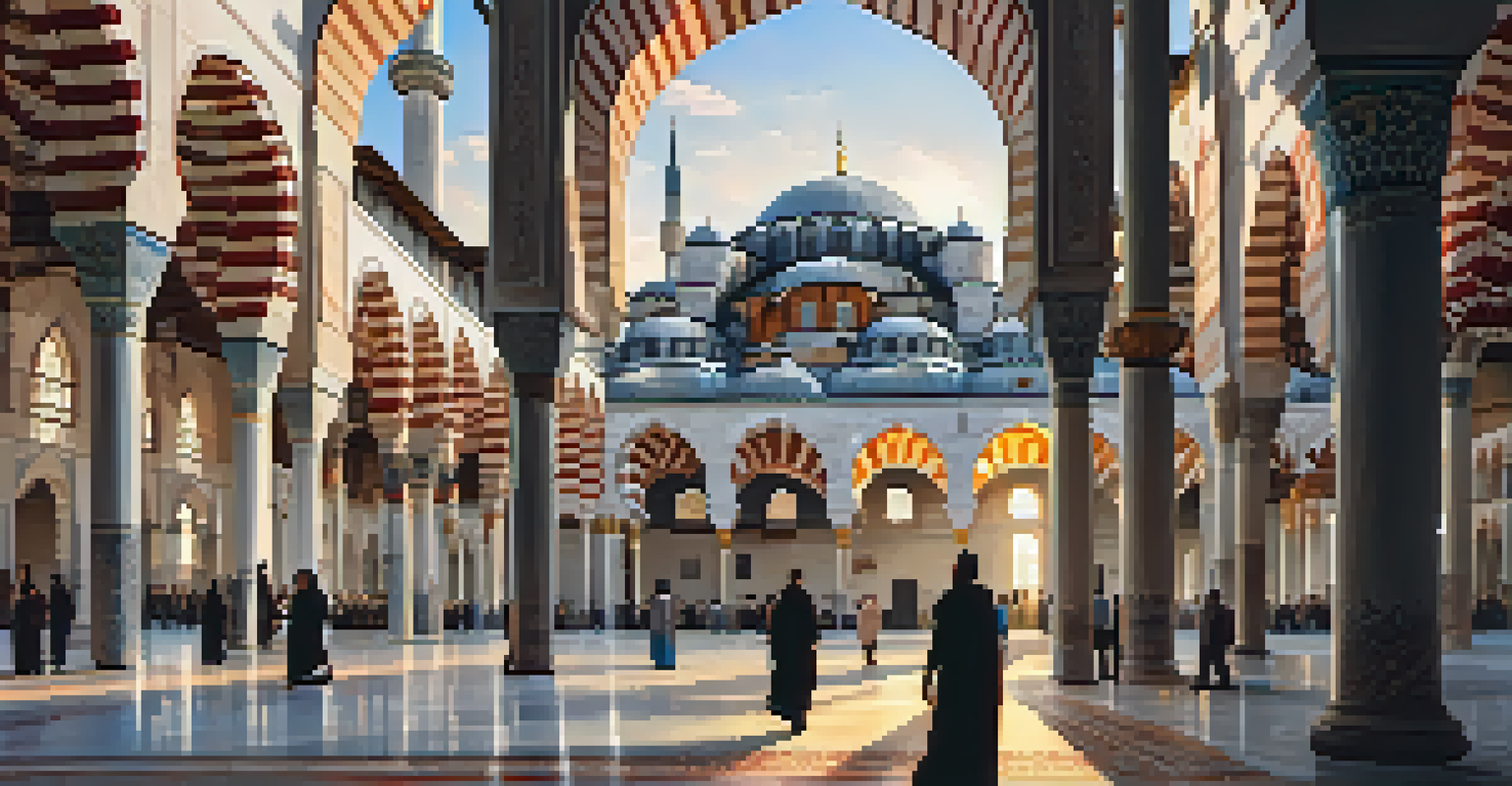The Influence of Islamic Architecture in Istanbul's Landmarks

Understanding Islamic Architecture: A Brief Overview
Islamic architecture is a fascinating blend of art, culture, and religion. It encompasses a variety of styles and influences, primarily seen in mosques, palaces, and public buildings. This architectural form evolved over centuries, adapting to local cultures while maintaining core design principles such as symmetry, intricate geometric patterns, and calligraphy.
Architecture is the thoughtful making of space.
One of the defining features of Islamic architecture is its focus on communal spaces, reflecting the importance of community in Islamic culture. These spaces often foster a sense of belonging and collective identity, highlighting how architecture can influence social interactions. In Istanbul, this communal aspect is prominently displayed in its many majestic mosques and public squares.
The rich history of Islamic architecture in Istanbul is marked by significant contributions from various empires, especially the Ottomans. This influence is evident in the city’s skyline, where beautiful domes and minarets tell stories of a vibrant past, merging artistry with functionality.
The Iconic Hagia Sophia: A Fusion of Cultures
Hagia Sophia stands as a testament to the blending of Christian and Islamic architectural elements. Originally constructed as a cathedral, it was converted into a mosque after the Ottoman conquest of Constantinople. This transformation introduced Islamic features, such as minarets and a mihrab, while still preserving its original Byzantine mosaics.

The vast dome of Hagia Sophia is an engineering marvel that influenced countless other structures. Its design showcases the innovative use of space and light, creating a sense of divine presence. Visitors are often left in awe of how the dome appears to float, a perfect example of the synthesis between different architectural styles.
Islamic Architecture's Cultural Role
Islamic architecture emphasizes communal spaces that foster a sense of belonging and social interaction within communities.
Today, Hagia Sophia serves as a museum, representing a bridge between cultures and religions. This unique blend of history and architecture invites visitors to appreciate the complexities of Istanbul's past, making it a must-see landmark for anyone exploring the city.
The Blue Mosque: A Masterpiece of Ottoman Design
The Sultan Ahmed Mosque, commonly known as the Blue Mosque, is another prime example of Islamic architecture in Istanbul. Completed in the early 17th century, it features a stunning array of blue tiles that give the mosque its nickname. The mosque is renowned for its grand scale, with a large central dome flanked by smaller domes and six elegant minarets.
The beauty of a place lies in the way it speaks to the heart.
One of the mosque's most impressive features is its interior, adorned with intricate mosaics and calligraphy. These artistic elements not only showcase the beauty of Islamic art but also serve to inspire contemplation and spirituality. The interplay of light and color within the mosque creates a serene atmosphere that draws visitors into a moment of reflection.
The Blue Mosque is not just an architectural gem; it is also a functioning place of worship. This dual role highlights the importance of maintaining cultural traditions while adapting to modern needs, ensuring that the mosque remains a vibrant part of Istanbul's spiritual landscape.
Topkapi Palace: A Reflection of Ottoman Grandeur
Topkapi Palace, once the residence of Ottoman sultans, is a stunning example of Islamic architecture that combines opulence with functionality. The palace complex features lush gardens, intricate tile work, and grand courtyards, all designed to reflect the power and wealth of the empire. The layout of the palace is carefully planned to create a sense of order and hierarchy, which was essential in the Ottoman court.
The architecture of Topkapi Palace showcases the blending of different cultural influences, particularly Byzantine and Persian styles. This eclectic mix enhances its beauty and provides insight into the empire's interactions with neighboring cultures. Visitors can explore various sections of the palace, each revealing unique architectural details and historical significance.
Hagia Sophia: A Cultural Fusion
Hagia Sophia exemplifies the blend of Christian and Islamic architectural elements, symbolizing cultural and religious coexistence.
Topkapi Palace is also home to an impressive collection of artifacts, including religious relics and imperial treasures. These items not only highlight the palace's historical importance but also connect visitors to the rich tapestry of Istanbul's past, making it an essential stop for anyone seeking to understand the city’s architectural narrative.
The Spice Bazaar: An Architectural and Cultural Hub
The Spice Bazaar, or Egyptian Bazaar, is a lively marketplace that reflects the essence of Islamic architecture and trade. Built in the 17th century, its design features a vaulted ceiling and colorful stalls, creating an inviting atmosphere for visitors. This architectural style emphasizes functionality, allowing for easy navigation through the bustling market.
The bazaar is not just a place to purchase spices; it also serves as a cultural hub where diverse culinary traditions converge. The vibrant atmosphere is enhanced by the scents of exotic spices, teas, and sweets, drawing locals and tourists alike. This experience illustrates how architecture can foster cultural exchange and community interaction.
As you wander through the Spice Bazaar, you'll notice the intricate details in its design, from decorative arches to beautifully crafted storefronts. Each element tells a story of the city's rich history and its role as a crossroads of trade, making it a fascinating stop for those interested in the intertwining of architecture and culture.
The Süleymaniye Mosque: Symbol of Ottoman Legacy
The Süleymaniye Mosque, an iconic symbol of Istanbul, showcases the height of Ottoman architectural achievement. Built in the 16th century under the reign of Suleiman the Magnificent, it combines grandeur with simplicity, embodying the principles of Islamic design. The mosque's large dome and spacious courtyard create an impressive sight against the city skyline.
Inside, the mosque features beautiful stained glass windows and intricate calligraphy that evoke a sense of peace and spirituality. The harmonious proportions and elegant details reflect the meticulous craftsmanship of the era, inviting visitors to appreciate the beauty of Islamic art. The mosque's design also emphasizes natural light, enhancing the serene environment.
Water's Importance in Design
Water features in Islamic architecture serve both aesthetic and practical purposes, enhancing tranquility and reflecting spiritual practices.
Süleymaniye Mosque is more than just a place of worship; it also includes a complex that houses a school, a hospital, and a soup kitchen. This multifunctional approach highlights the role of architecture in serving the community and emphasizes the Ottoman commitment to public welfare, making it a vital part of Istanbul's cultural heritage.
The Role of Water in Islamic Architecture: The Case of Istanbul
Water plays a pivotal role in Islamic architecture, symbolizing purity and life. In Istanbul, this is beautifully illustrated through the presence of fountains, pools, and hammams (Turkish baths) within many architectural complexes. These water features not only enhance the aesthetic appeal but also serve practical purposes, offering refreshment in the bustling city.
The use of water in places like the Topkapi Palace and various mosques creates serene environments for relaxation and contemplation. Fountains often serve as focal points, drawing visitors in and providing a soothing soundtrack of flowing water. This connection to nature highlights the importance of tranquility in Islamic culture and architecture.

Moreover, the presence of water is intricately linked to Islamic rituals, such as ablution before prayer. This necessity further emphasizes how architecture can accommodate spiritual practices while enhancing the overall experience for worshippers. In Istanbul, these elements come together to create a unique blend of functionality and beauty.
Istanbul’s Architectural Legacy: A Lasting Influence
Istanbul's skyline, adorned with remarkable Islamic architecture, serves as a constant reminder of the city's rich historical legacy. The influence of Islamic design extends beyond its own borders, inspiring architects and artists around the world. This architectural heritage continues to shape contemporary designs, ensuring that the principles of beauty, symmetry, and community remain relevant today.
The preservation of these landmarks is essential for maintaining the cultural identity of Istanbul. Efforts to restore and maintain historic sites allow future generations to appreciate the artistry and significance of Islamic architecture. Such endeavors foster a sense of pride and connection to the past, reinforcing the importance of cultural heritage.
As Istanbul evolves into a modern metropolis, the integration of traditional Islamic architectural elements into new developments reflects a respect for history. This harmonious blend of old and new not only celebrates the city’s architectural journey but also invites ongoing dialogue about the role of culture in shaping urban landscapes.